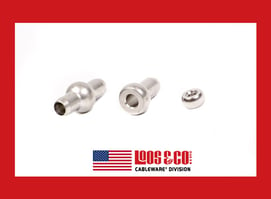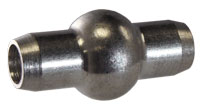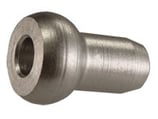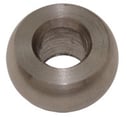Ball End Terminals: Three Styles available when Stop Action is Needed
Aircraft Cable assemblies have two basic components: the aircraft cable and the terminal. In its simplest form, these components work together as a unit to convey forces from one point to another. The aircraft cable in an assembly allows for the forces applied to be conveyed over distance, sometimes linearly, and sometimes over pulleys or sheaves as part of a mechanical system. The terminal or terminals in an assembly allow the aircraft cable to be attached in one form or another to the points on which the mechanical actions are happening, a connection between the mechanism creating the force and the device or location on which the force is acting.
As the applications for aircraft cable assemblies have been developed through the years, the multiple styles of terminals have evolved with them. Terminals have been developed and standardized for specific applications, with many receiving Aerospace Standards and Military Specification oversight to promote quality and uniformity in the field. This variety of end fitting design makes it possible to use aircraft cable in a range of devices, regardless of size, shape, strength, or function required. Understanding the different terminal styles, the variation within those styles, and how these differences affect performance allows engineers to ultimately create the solution they need in any aircraft cable application.

Ball End Terminals provide secure connections with torque relief in Aircraft Cable Assemblies
Ball ends come in three different Styles: Plain Ball, Single Shank, and Double Shank. This fitting style is used in application where a stop style termination is needed along with the ability to relive torque from the cable assembly. As cable moves linearly, over pulleys, or around corners, the wires in the cable move back and forth over each other while being twisted with the forces acting on them. This builds stresses that fatigue the wires, and will ultimately result in broken wires, and eventually a broken cable. This is all part of the normal life cycle of an aircraft cable assembly, and the proper design of the assembly is meant to reduce this wear as much as possible and to extend the service life of the aircraft cable. The ability of the assembly to relieve that torque and tension is the role of the ball end terminal. This is accomplished through the rounded ball design and the accompanying "saddle" or "cup" connection on the receiving end of the assembly. This allows the assembly to "spin" when the forces build up. You can see an example of that design in the mating location of the Strap Fork terminal often used in conjunction with ball ends.
Double Shank Ball Terminal:  Ball is in the center of two shanks. Used often times in the center of an aircraft cable assembly to allow for pulling a mechanism in opposite directions. Available in commercial versions and under MS 20663 Military Speciation for aircraft flight controls and other critical applications. Also covered under MIL-DTL-781 for the General Specification of Wire Rope Terminals and Swaging. When properly swaged, this terminal will hold the full break-load of the it was designed for.
Ball is in the center of two shanks. Used often times in the center of an aircraft cable assembly to allow for pulling a mechanism in opposite directions. Available in commercial versions and under MS 20663 Military Speciation for aircraft flight controls and other critical applications. Also covered under MIL-DTL-781 for the General Specification of Wire Rope Terminals and Swaging. When properly swaged, this terminal will hold the full break-load of the it was designed for.
Single Shank Ball Terminal:  Ball is at the end of a single shank. Used often times used at the terminating end of an aircraft cable assembly for forces applied in a single direction. Many times used on conjunction with a Strap Fork terminal. Available in commercial versions and under MS 20664 Military Speciation for aircraft flight controls and other critical applications. Also covered under MIL-DTL-781 for the General Specification of Wire Rope Terminals and Swaging. When properly swaged, this terminal will hold the full break-load of the it was designed for.
Ball is at the end of a single shank. Used often times used at the terminating end of an aircraft cable assembly for forces applied in a single direction. Many times used on conjunction with a Strap Fork terminal. Available in commercial versions and under MS 20664 Military Speciation for aircraft flight controls and other critical applications. Also covered under MIL-DTL-781 for the General Specification of Wire Rope Terminals and Swaging. When properly swaged, this terminal will hold the full break-load of the it was designed for.
Plain Ball Terminal:  Ball is swaged to cable without a shank. Can be used at any location along the length of an aircraft cable assembly for forces applied in a single direction or in opposite directions. Available in commercial versions and meet all requirements for Boeing’s BACT14B Plain Ball End Fittings and NAS494 series Plain Ball End Fittings. All balls are manufactured from stainless steel as specified in MIL-DTL 781 and are certified to the appropriate standard(s). This terminal will not meet the full break load of the cable it is designed for, so extra consideration must be given in the aircraft cable assembly design to include proper safety factors.
Ball is swaged to cable without a shank. Can be used at any location along the length of an aircraft cable assembly for forces applied in a single direction or in opposite directions. Available in commercial versions and meet all requirements for Boeing’s BACT14B Plain Ball End Fittings and NAS494 series Plain Ball End Fittings. All balls are manufactured from stainless steel as specified in MIL-DTL 781 and are certified to the appropriate standard(s). This terminal will not meet the full break load of the cable it is designed for, so extra consideration must be given in the aircraft cable assembly design to include proper safety factors.
While multiple styles of terminals have evolved through the years, it's inevitable that new challenges will arise and new solutions will need to be developed. As a manufacturer, Loos & Co., Inc can engineer a terminal solution to meet your exact requirements. Learn more about the development process and our Precision Machining Capabilities by visiting the Loos & Company Precision Products site. And as always, if you have any questions, or would like to request am aircraft cable terminal quotation, don't hesitate to contact us today.